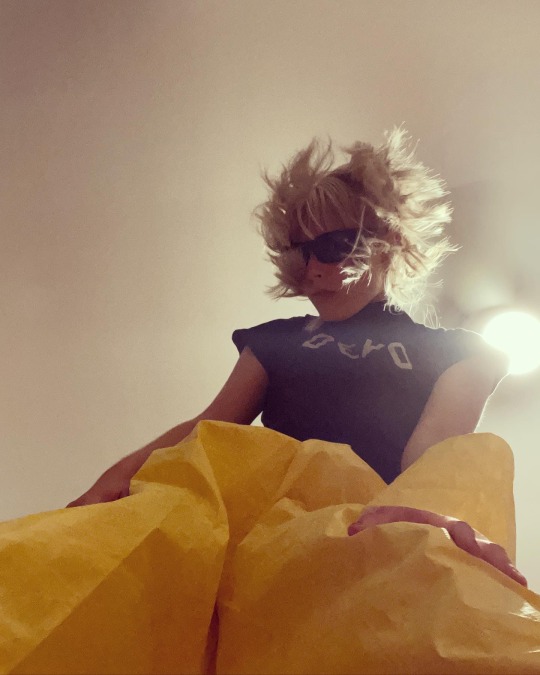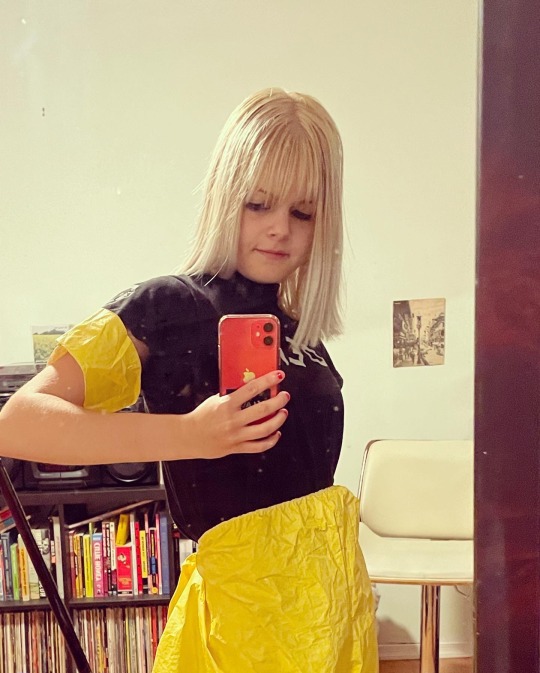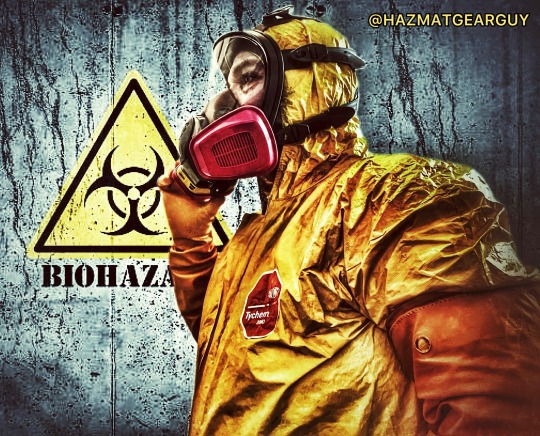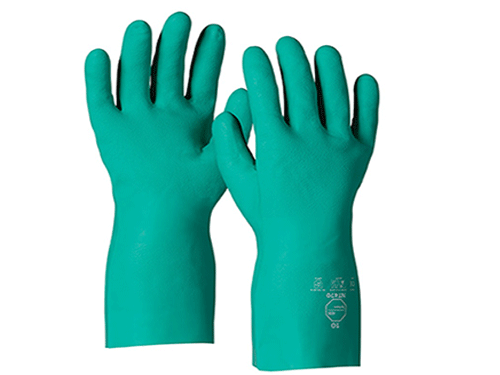#tychem
Text
I will be entering a highly toxic area, therefore it is mandatory to wear required safety gear. Including a DuPont Tychem suit, 3M full face respirator, and chemical resistant gloves. ☣️
#hazmat suit#hazmat#tychem#full face respirator#respirator#protection#safety gear#guysingear#decontamination#decon#work wear#workwear#hazardous chemicals#biohazard
27 notes
·
View notes
Text
realizing that my lab coats, tychem coveralls, fall arrest harness, variety of chemical handling gauntlets, hard hats, high vis vests, and shop jumpsuit are all just evidence that i like playing dress-up, when you consider that i’m an evangelist of the hierarchy of controls
#by the way#every one of these items requires nontrivial research if you’re going to use them in the field#do NOT just buy whatever on amazon#i’m happy to answer questions about these garments if you have them#safety first! i mean it!
0 notes
Text





DEVO damaged.
#it’s a long story#and it’s terminal too#me#selfshot#DEVO#DEVO pants#DEVO suit#radiation suit#tychem#mutated#devolved#near death#beyond help#shades#DEVO shirt#spud#spudette#nerd#highest waists in the game#big pants#JNCO#photos
17 notes
·
View notes
Photo




Last fall I started an Amazon store, and threw in some TyChem suits on there just for fun.
I picked up a AirBoss Defense dealership mostly because I wanted to rock the LBM at the DARC Level 1 class I had gotten invited to... and figured it made sense to learn the basics of CBRN stuff from EOD, CBRN, and first responder pals I know.
Who knew I’d actually end up using all that stuff in 2020!
All I can say is that I’m very glad that the Corona Virus is not as deadly as it could be, and that its main danger is asymptomatic spread which is mostly a threat to the extra vulnerable.
I still don’t want it, masking and gloving up everytime I go out.
WO remains open for business as one of the few west coast distributors for high grade PPE among other things. We got the “essential” designation, twice over. A little strange but whos 2020 isn’t at this point.
186 notes
·
View notes
Photo

Marina Zurkow
HazMat Suits for Children, 2012
Tychem® TK fabric, acrylic, Velcro, rubber, mannequin
46 x 12 x 12 in / 116.8 x 30.5 x 30.5 cm
88 notes
·
View notes
Link
UK Suppliers of ALL Dupont Tyvek Disposable Coveralls and Polypropylene Suits
0 notes
Text
Protective Clothing Market projected to see huge profits during the forecast period 2029
Global Protective Clothing Market: Overview
The global protective clothing market is growing at a steady pace, credit a sturdy growth rate, compounded annually. The CAGR will help the market players witness a slew of profitable opportunities arising over the forecast period of 2019 to 2027.
It is significant to note here that a number of industries demand protective clothing for employees owing to high risks associated with the job. Some of these include manufacturing, oil and gas, construction, and chemical. As regulation around the safety of these workers gain prominence, demand for protective clothing would see an upward curve. Governments across the world are taking cognizance of these measures and their usefulness, pushing the market on a high growth trajectory. This is particularly true of the developing regions of the world.
More insightful information | Request a sample copy @ https://www.trendsmarketresearch.com/report/sample/13455
Region-wise, Asia Pacific and North America would be regions worthy of setting the eyes on over the forecast period. Are you a start-up willing to make it big in the business?
Global Protective Clothing Market: Notable Development
A number of strategic manoeuvres are noted in the market landscape of protective clothing. Players are making efforts towards claiming a better position over the forecast period.
In the year 2019, DuPont Safety and Construction came up with a new portfolio of sleeve and glove solutions. It is called Tychem and Kevlar. The solutions are for the Indian market. It improves workplace protection in a number of environments that pose dangers. These include automotive, manufacturing, and oil and gas. This increases competition for the other players and helps the company consolidate its position in the regional market
The global Protective Clothing market is competitive and slightly fragmented. The players that are helping the global protective clothing market grow with their active pursuit of innovation and higher market share are outlined below:
3M Company (US)
E.I. du Pont de Nemours and Company (US)
Ansell Limited (US)
Kimberly Clark Corp (US)
Teijin Limited (Japan)
Sioen Industries (Belgium)
Lakeland Industries, Inc. (US)
Looking for Regional Analysis or Competitive Landscape , ask for a customized report
Global Protective Clothing Market: Key trends and driver
Talk to our Analyst / Ask for a discount on Market and Get More Information Related to This Report@ https://www.trendsmarketresearch.com/report/discount/13455
The global Protective Clothing market is on a upward trajectory owing to numerous factors - trends and drivers. Some of the major factors that are marking the forecast period of the global protective clothing market are spelled out below. These include growth in manufacturing and increase in construction volumes.
Growth in manufacturing will lead to growth in protective clothing market. Based on performance and application, material selection is made in the industry. These are important to ensure casualties are prevented and on the job injuries are reduced. Additionally, increase in construction activities is creating demand for protective clothing, making the market grow by a substantial amount.
An 85% increase in construction volumes is anticipated by experts in the construction market by the year 2030. That means need for protective clothing will increase in step with it. The construction growth would be highest in the countries of United States of America, India, and China, which will account for 57% of the growth.
Global Protective Clothing Market: Regional Analysis
The largest regional market in the global protective clothing market is that of North America. Over the forecast period, the region will continue the trend. Multiple factors help the North American market maintain dominance. Some of these are high levels of awareness, strict safety regulations, and presence of various companies in the market landscape. Players in the region are highly focused on development of more effective clothing. It is no surprise that the region is marked by innovation and that will be the primary force driving the market onto a high growth trajectory.
The report offers a comprehensive evaluation of the market. It does so via in-depth qualitative insights, historical data, and verifiable projections about market size. The projections featured in the report have been derived using proven research methodologies and assumptions. By doing so, the research report serves as a repository of analysis and information for every facet of the market, including but not limited to: Regional markets, technology, types, and applications.
0 notes
Text
Impact of COVID-19 on PPE in the Healthcare Industry

COVID-19 Impact on PPE in the Healthcare Industry
The outbreak of COVID-19 is having a huge impact on the healthcare industry majorly the PPE (Personal Protective Equipment). PPE includes gloves, mask, gown, goggles, N95 respirators, and hand sanitizer. Currently, it is the only preventive measure for the healthcare professional to prevent themselves from the spread of corona virus.
Many countries are involved in manufacturing of PPE products. Among which, China is the largest producer. According to the UNICEF, China produces approximately 50% of global surgical masks. Other countries include Taiwan which produces around 20% of global supply of face masks alone followed by India, Mexico, U.S., Japan, Malaysia, Korea, European countries, and others.
IMPACT ON DEMAND
Rising number of cases of corona virus is increasing the demand of PPE across the globe. According to the UNICEF, the demand for PPE products has surged 1000-2000 fold. Earlier in 2017-2019, the annual demand for coveralls and gowns by low and middle-income countries sourced by UNICEF did not exceed 50,000 units. However, the current demand for three months of these products is around 25 million. Similarly, for different types of facemasks, earlier the annual average procurement sourced by UNICEF was not more than 25000 units but now it has exceeded 55 million due to this target disease.
Furthermore, according to the WHO, there is a need of around 89 million masks for the COVID-19 response every month. While for gloves, the demand goes up to 76 million and for googles, it is around 1.6 million every month.
Moreover, the rising demand for N-95 masks has impacted the manufacturing of other PPE products. Companies have shifted their focus towards gloves and masks and have stopped manufacturing other products such as chemical resistant gloves, welding helmets, and industrial safety glasses.
IMPACT ON SUPPLY
Due to the rising demand of PPE, misuse, hoarding, and panic buying, there is a severe disruption in the supply chain of PPE. This has increased the risk for healthcare workers with limited access to PPE supplies during the care of COVID-19 patients. As the outbreak started in China, it has become the major cause of supply chain disruption.
SINCE THE OUTBREAK OF COVID-19, WHO HAS SUPPLIED PPE TO THE FOLLOWING COUNTRIES:
· Western Pacific region: the Philippines, Vanuatu, Tonga, Solomon Islands, Samoa, Papua New Guinea, Nauru, Mongolia, Lao People's Democratic Republic, Kiribati, Fiji, and Cambodia.
· Southeast Asia region: Timor-Leste, Bangladesh, Nepal, Myanmar, Maldives, and Bhutan.
· Eastern Mediterranean region: Iran, Morocco, Jordan, Sudan, Pakistan, Somalia, Lebanon, Djibouti, and Afghanistan.
· Africa region: Zimbabwe, Seychelles, Madagascar, Senegal, Algeria, Ethiopia, Angola, Togo, Ivory Coast, Kenya, Mauritius, Nigeria, Uganda, Zambia, Tanzania, Ghana, Mauritania, Equatorial Guinea, Gambia, and Mozambique
IMPACT ON PRICE
With rising demand, and shortage of supply, the price for the PPE products is increasing with an exponential rate. The supply chain disruption has become an opportunity for the suppliers to raise the price of PPE by a factor of 20. In addition, presence of market manipulators can also increase the time of delivery at the needful place. These manipulators can purchase the stock by bidding at higher price.
The price of surgical masks has risen 6 times, threefold for N95 respirators, and twofold for the gowns.
REASONS FOR THE BACKLOG OF PRODUCTS
· Raw materials: Due to the high demand for PPE products, there is a shortfall in raw materials used in manufacturing these products. Such as, due to high requirements in N95 masks, there is a shortage in nonwoven polypropylene.
· Machines: To meet the demand gap, there is a need to increase in production facilities. Thus, requiring large number of machine to manufacture the products. However, it takes around 6 months to assemble a machine to streamline it.
· Geographic concentration of manufacturers: High dependence of global manufacturers on People’ Republic of China is major factor for the backlog of products. Due to this pandemic situation, there has been a shutdown in China and many workers were quarantined. Thus, the production of PPE products was reduced.
· Export bans: As the corona virus was spreading at an exponential rate, many countries restricted the travelling of people and movement of products from one country to other. In addition, the countries exporting PPE products to others also banned the supply of these products so as to meet the domestic demands. As of March 2020, 22 countries implemented export bans. These countries include India, japan, Bangladesh, France, Germany, Malaysia, Jordan, Kenya, Pakistan, China, Thailand, and other countries.
· Other reasons: Low availability of transportation, limited workforce, and roadblocks are the other reason leading to the shortage of products.
STRATEGIC DECISIONS FOR REDUCING THE DEMAND GAP
With the decline and ineffective supply chain management, government and manufacturers are taking initiatives to effectively manage the supply of PPE and make appropriate use of these products in healthcare settings. The capacity to expand PPE production is limited, and the current demand for respirators and masks cannot be met, if widespread inappropriate use of PPE continues
GLOBAL MANUFACTURERS INITIATIVES
SOME OF THE COMPANIES WITH REAL-TIME CONNECTIVITY AND TECHNOLOGICAL ADVANCED SUPPLY CHAIN MANAGEMENT ARE ALSO HELPING THE WORLD IN MEETING THEIR REQUIREMENTS.
For instance,
· 3M is increasing the production via its international manufacturing facilities in Europe, Asia, and North America. However, the company due to no hike in prices of its respirators, retailers and dealers are not responding properly.
· DuPont Initiatives:
1. The company launched Tyvek Together Program to increase the production of Tychem and Tyvek personal protective garments to protect the healthcare workers. Since, January 2020, the company has increased its production by 9 million garments per month. Under this program, the company is focusing to develop 15 million garments per month. In addition, the company will donate more than 57000 Tyvek coveralls to the U.S. states which are most affected by COVID-19.
2. DuPont entered into partnership with FedEx and the U.S. Department of Health and Human Services (HHS) to accelerate the delivery of PPE products. FedEx will help in transporting Tyvek roll goods from manufacturing site in the U.S. to the Vietnam facility and then the finished product is returned to the U.S.
· DuPont entered into partnership with Cummins, Inc. to meet the demand of N95 respirator masks.
GOVERNMENT INITIATIVES
WHO is working with the Pandemic Supply Chain Networks, industries, and governments to accelerate the production of these products. It estimates that manufacturing should be increased by approximately 40%. In addition, rising government support for the production of PPE is expected to boost the PPE market. These include delivering equipment in countries with urgent needs, easing the restrictions on distribution and export of the medical supplies, providing guidance on the rational use of PPE, and others.
THE FOLLOWING ARE THE MEASURES TAKEN TO OPTIMIZE THE AVAILABILITY OF PPE:
· Minimize the need for PPE
· Use of telemedicine
· Use physical barriers to reduce exposure
· Restriction of healthcare workers in COVID-19 patient’s room who are not involved in direct care.
· Appropriate and rational use of PPE
#PPE Market#PPE Market Analysis#PPE Market Analysis in Developed Countries#PPE Market by Type#PPE Market Development#PPE Market Forcast#PPE Market Future Innovation
0 notes
Link
quan ao chong hoa chay dupont tychem C, quần áo chống hóa chất dupont tychem C
0 notes
Text

WARNING⚠️ THIS IS A BIOHAZARD AREA. HAZMAT GEAR IS REQUIRED TO ENTER.☣️
#hazmat suit#hazmat#tychem#full face respirator#respirator#gas mask#protection#gloves#work gloves#chemical warfare#hazardous chemicals#biohazard#guysingear#masked men#protective wear#work wear#safety gear
15 notes
·
View notes
Text
Disposable Chemical And Flame Resistant Garment
Disposable Chemical And Flame Resistant Garment
Brand
Safety India
Minimum Order Quantity
10 Piece
Product Type
Overalls
Feature
Breathable
Model
CRFR
Material
Tychem, PVC, or as per customer need
Wear Type
Not Reflective
Gender
Unisex
Size
All Sizes
Color
Dark Grey
Descriptions
RFR Disposable, Chemical Resistant, and Flame Resistant, all rolled into one garment.
Expanded back for SCBA, hood, storm flap over zipper, elastic face,…

View On WordPress
0 notes
Photo

When you’re supervising crews responding to Haz Mat, blood borne pathogens and other things for a living and have to suit up at home for a backed up sewer line that flowed under the house. For those that know how bad that smell is and the work it takes with all the crap (literally and figuratively) I wasn’t risking exposure to anything while sucking up untouched dust kicking just trying to get to it. Using a 3M full visor mask and DuPont Tychem 2000 coveralls to get to work. It’s been a long four days just after recovering from a cold. Post apocalyptic photo, just need my rifle and pack. #survival #prepper #preparedness #sewer #survivalgear #gasmask #respirator #3m #dupont #covid #apocalypse #bushcraftandprepping #shtf #shtfready #postapocalyptic #pandemic #pandemiclife #pandemic2020 https://www.instagram.com/p/CIg9OBYJZ1i/?igshid=ljz74iz2e5q
#survival#prepper#preparedness#sewer#survivalgear#gasmask#respirator#3m#dupont#covid#apocalypse#bushcraftandprepping#shtf#shtfready#postapocalyptic#pandemic#pandemiclife#pandemic2020
0 notes
Text
Tychemed Examination Couch


[ad_1]
Examination Couch With CABINET & DRAWERS
Overall Approx size: 187L x 51W x 81H.cms Adjustable backrest by gas spring system.
Two Section Foam padded, upholstered top.
Tray for B.P. Apparatus provided near head rest.
Finish : Pre treated & Epoxy Powder Coated./ Baked Paint
[ad_2]
View On WordPress
0 notes
Photo

(via FREE Dupont Tychem Gloves (fill out a short form))
0 notes
Text
Racing Against Coronavirus

The global coronavirus pandemic shut NASCAR down for two months. The racing at Darlington Raceway on May 17 won't look like anything we've ever seen before. But will those precautions keep drivers, crews, and media safe?
Why Worry About Viruses?
There are millions of types of viruses in the world. Some only infect plants (mosaic tobacco virus), some affect animals (Bordatella) and some attack people (Measles and Coronaviruses, for example.)
How Viruses Work
Viruses contain DNA or RNA, which are basically instruction books that tell a cell what to make. Coronavirus is a RNA virus.
Viruses can't replicate on their own: They need a cell to make more of themselves. A virus's RNA or DNA is wrapped in proteins that help the virus attach to and break into cells. Once inside, the DNA or RNA tells the cell to make thousands more copies of itself. A virus hijacks your body's cells and turns them against you.
Viruses mutate: Copying a virus can introduce mistakes in the genetic code. Mistakes that help the virus survive become part of the virus. Those reproduction mistakes help us track the virus the same way DNA lets people track their genealogy.
Coronaviruses got their name because the way the proteins are arranged on the outside makes it look like a corona or halo. Ebola is an arenavirus, which was named because arena is latin for sand and arenaviruses look like tiny sand particles under a microscope.

Transmission
Viruses are small: the diameter of a human hair is about 80 microns. Typical viruses are a tenth of a micron. (For comparison, a cell is about 10 microns.) The limit of human vision is about 40 microns, so you can't see a coronavirus. And, at that size, it's hard to find any normal material that could be used for PPE.

Luckily for us, Coronavirus is spread through droplets. When you cough or sneeze (or, to some extent, talk), you spew droplets into the air. Smaller, lighter droplets travel further in the air. Coronavirus droplets are from two tenths of a micron to a couple hundred microns.

This is where that six-foot number comes from.
How to Stop Coronavirus
First and foremost, keep it containedMasks are not there to protect you: They're there to keep you from introducing coronavirus into the environment. You can have the coronavirus and never have any symptoms, but if you're sneezing all over the place, some person at higher risk than you (grandparents, people doing chemotherapy, people with a hampered immune system) can pick it up from you. If you've been exposed, isolate yourself from everyone for 14 days, which is the time it takes for the body to make enough copies of the virus that you start to experience symptoms.Clean, clean, clean. Coronavirus can survive on surfaces for times from a few hours to a few days. Disinfectants containing at least 60% alcohol break the virus open, thus rendering it inert.This does not work inside the body, so no, this is not an excuse for you to spend your days drinking beer. Soap and water dissolves the fatty lipid shell around the virus, again, rendering it inert And for heaven's sake, don't drink disinfectants or bleach!Also, never mix bleach with any cleaner containing ammonia. It creates a chlorine gas that can kill you.
What NASCAR is Doing
NASCAR will be one of the first sports back with live offerings when the series races at Darlington Raceway on May 17th. The coronavirus poses new issues for the sanctioning body.
Are Outdoor Sports Less Likely to Spread the Coronavirus?
Some people argue that NASCAR is an outdoor sport and thus doesn't have the same problems as a sport like basketball.
In general, that's true that outdoors is better, but that's not because of temperature or more fresh air: it's because there is more room to spread out. That should decrease the number of times you interact closely with other people.
Baseball is an outdoor sport, too, but there's no way to keep the ump and catcher six feet from the batter. And putting the players in the dugout isn't really much better than locking them in a room.
NASCAR is using all these factors to their advantage.
Tracks are big. They have lots of room to spread out, especially with no fans. Every other garage stall will be used, which means some teams will be setting up their garage in the motorhome lot at Darlington.NASCAR's further limited the number of people each team can bring to 15, including the driver. That's down by about five people per team, which means there are 225 or so fewer people at the track. Fewer people means fewer interactions.Single-day races within driving distance of Charlotte eliminates the need for motorhomes, hotels, and airplanes -- however, teams do still have to get to the track. Even stripped down, without fans, there will be in the neighborhood of 2000 people at Darlington on the 19th.
Can NASCAR Ensure No One Who's Sick Gets Into the Track?
Unfortunately, no. They will be taking temperatures entering and leaving the track, but we've seen that
It's possible to have the coronavirus and not exhibit any symptomsIf you have the coronavirus, you are contagious before you exhibit any symptoms like fever.
Will NASCAR Test Everyone?
The only thing a coronavirus test tells you is that you have the virus. Results take 2-3 days, so a test can't be used at the entry to select out anyone who might be sick. There are faster test machines, but they need to be used in hospitals, not at racetracks.
NASCAR opted against antibody tests. At this point, they're not reliable enough, plus we don't know for sure whether having had the virus makes you immune to getting it again -- especially if the virus mutates quickly.
NASCAR prioritizes protection over detection, which means assuming the worst case -- that someone is carrying the coronavirus -- and making sure it can't spread.
Doesn't Pit Crew Equipment Protect Them Already?
During the debate about whether we should have pit stops in the first races back, some people argued that the pit crew, next to the driver, has the most safety equipment, so why eliminate pit stops?
While it's true that pit crews wear a lot of safety equipment, that equipment is optimized against impacts and fire, not viruses.
Viruses can live on your skin for a long time. That's why you shouldn't touch your face and you should wash your hands every chance you get. Any viruses you've picked up with your hands can get into your nose or mouth: two favorite entryways for viruses.
There are huge differences between biosafety suit and a firesuit.

A lot of the issue comes down to woven vs. non-woven fabrics -- something that's been discussed a lot in reference to hospital-grade PPE and homemade masks.
Woven fabrics have holes. Tiny holes, but remember that viruses are even tinier. In contrast, the fibers in non-woven fabrics are randomly arranged, leaving much smaller (if any) holes. Multiple layers of non-woven fabrics are used for hospital-quality PPE -- but they're also difficult to breathe in.

Firesuits are made from woven Nomex (or other fire-resistant) fibers. There's no difference between a firesuit and a quilted coat until the suit is exposed to fire. Biosafety suits are made from non-women materialsTyvek is a non-woven, hard-to-tear material high-density polyethylene that allows water vapor in or out, but not water The United States Postal Service uses Tyvek for some Priority and Express Mail envelopesHouses are often wrapped in Tyvek sheets.Tychem is also non-woven and hard-to-tear, but has a higher resistance to liquids.
If you've ever tried a sauna suit -- an impermeable material that makes you sweat so that you lose water weight -- you know that no one wants to do a pit stop in Tyvek or Tychem.
Helmets
Racing helmets protect against impact. Even a full-face helmet with a visor won't keep a virus out, so NASCAR will require pit crew members to wear either:
a face shield that goes from above the eyes to the china fire-resistant balaclava (sock mask) that covers the nose and mouth.
Even during pit stops, the pit crew wears the equivalent of a face mask.
Face Masks
Everyone will wear face masks at all times they are around anyone else. There won't be any conversations over lunch because everyone will have to spread out far enough that it's safe to remove masks.
Remember: Face masks don't protect you: they protect everyone else from you. And vice-versa.
It's not me I worry about. It's the forty-two other &@@holes out there.Michael Waltrip
I know where I've been and who I've been in contact with, but I have no way to know that about you. Wearing a mask protects your fellow workers, plus the wife undergoing chemotherapy, the grandfather suffering from diabetes, and the child with an undiagnosed heart problem.
Refusing to wear a mask is giving everyone around you the middle finger. You're broadcasting that you don't care if they get a disease that might kill them and their family.
NASCAR can fine any competitor $10,000 to $50,000 for not following the new health and safety rules, including mask wearing.
Why Isn't Practice Safe? Or Qualifying?
Another argument says that there's no point in limiting on-track time because the drivers are all in their own cars. That misses the reality of what happens in the garage. Here's why there's no practice or qualifying.
The car must arrive at the track ready to race. This eliminates time spent in the confines of the garage setting the car up, which minimizes person-to-person contact.There's no need to have a back-up car, which means less demand for person-power back at the shop.There will only be one inspection, which will happen right after the teams unload. They'll use a staggered entry and exit to/from the track to control the flow of people.
What If the Worst Happens?
Sure, there's a positive to being the only live sport back. We know people starved for sports who might not normally watch NASCAR plan to tune in. It's a great chance to get new fans.
But what if there's a coronavirus outbreak at the track?
NASCAR's already thought about contact tracing. Team members are required to note who they interact with, but NASCAR is working on a phone-based app to do this.
The idea is simple. Everyone who wants to be at the track must install the app. When your phone gets within six feet of another person's phone, they ping each other (probably via bluetooth) and record the interaction. If someone does come down with COVID-19, the app notifies everyone who was in contact with that person so that they can quickly quarantine.
What's the Best that Could Happen?
NASCAR is working with local and state health authorities, but I really hope they are engaging with public health researchers because this is a unique environment in which to study techniques to prevent coronavirus spread. NASCAR can enforce 100% compliance with the safety recommendations -- something that isn't possible most places. It's a small, well-defined system from which we could learn a lot about this disease and how to operate safely while it's still uncontrolled.
Read the full article
0 notes
Video
Opening Video, Dupont Tychem CPF3 Suit Ensemble, Awesome!! Check It Out!! Hazmat Suit? Corona Suit? My website https://ift.tt/2lRWE4R YouTube channels https://www.youtube.com/MOBADeanGaming https://www.youtube.com/DeansDailyDoses Daily Motion channel https://ift.tt/2B3KRoU TopBuzz channel https://ift.tt/3coCypV... Metacafe channel https://ift.tt/3crbO8h... GameJolt profile https://ift.tt/2pqYJHq Mobcrush website https://ift.tt/2pQATlj
0 notes